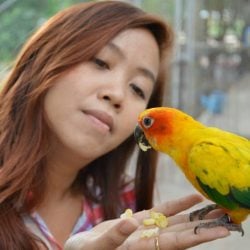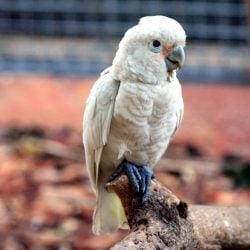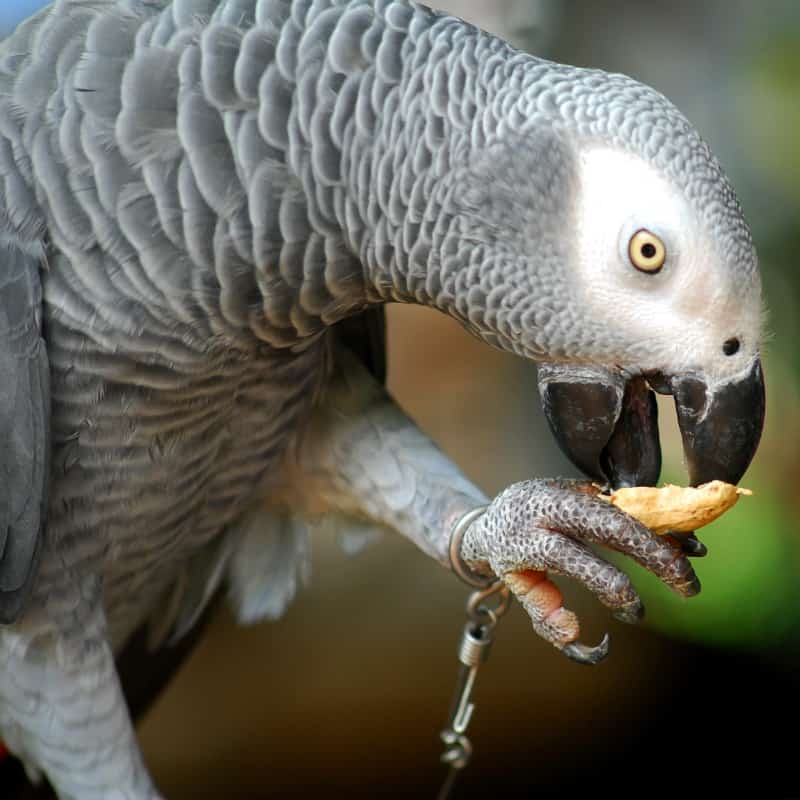Last Updated on by Mitch Rezman
Tory Violette writes,
Hi Catherine and Mitch, I’m writing about Jasper my Congo African Grey who is now 8 months old.
Well since he was about 16 weeks old he has been doing the motions to regurgitate his food when I pet him and talk to him.
Well yesterday morning it finally happened. He brought up food and he really worked hard at bringing up the food.
I know that it has something to do with him wanting to make me his mate. At least that’s what I was told a long time ago.
My Macaw did that and the place I got him from told me that’s he was doing. He was trying to give me his food as he would do in the wild if he had a mate. The male will feed the female. I see that in my back yard with Cardinals.
The male always feeds the female the peanuts that I give him, when he comes and asks for it. So what can i do with Jasper if this is what he is doing. Is there any advise you can give me?? He is an extremely lovey bird.
More so than I have seen in a bird. when he sits with me on the couch he does weird things, like try and rub against me. He is always trying to get in the position to have his head pointing downward and his bottom end up toward my shoulder. I put him over on his portable perch when he gets to over whelming.
Then he poops right away and wants to come right back. I have trained him basically to poop on command. When I try and leave him there longer then if I was just putting him there to do his thing. He gets upset and stomps his feet and yells at me.
So could you please tell me for sure if that is what he is doing when he regurgitates his food. Every time I pet him and talk to him he starts that motion to regurgitate. Thank you very much
TORY V.
Dear Tory, it sounds like you have a female, not a male. And she is getting in the mood. You may be bringing some of this on yourself. Birds that are pet below the neck basically consider it “foreplay”, you will have to restrict your petting to the head and neck only, not stroking down the body, etc.
Avoid letting her rub herself against you, re-arrange the cage as well, moving everything all around to give her some distraction and anything that allows her to rub against it in just the right spot and hopefully shift her out of her comfort level and thus become less broody.
NO tents, NO cozys, NO piles of paper to play in, NO boxes.
Cover her cage 10-12 hours a night and if she is not able to have quiet bed time where her cage is (you stay up late with the loud TV/music on or walk by the cage all the time), then get her a sleeping cage (it can be a lot smaller than her regular cage) that she can go into at night in a quiet dark room.
NO closets. (yes, people have done that). How many toys are in her cage? Add more, foraging type toys for treats and pellets, less shreddable toys. A greys cage should have 15-20 toys in it lining the inside the top third of the cage, like a canopy of leaves. Plus some foot toys on the bottom.
Does she usually expect to be held or on your shoulder when off her cage? Do you have stands for her in all the rooms you take her into? If not, then you need them. She can be with you, but not ON you.
There should be toys, etc on each of the stands. Is she clipped? Let her walk behind you, don’t carry her around all the time. Exercise helps too. If not clipped, then let her fly if she is familiar with the area, WITH a location she knows is there for her to land. (thus the extra stands). If she lays an egg, and it does not break.
Put it in an open box with some padding and let her tend to it until she gets bored, or breaks it. 3-4 weeks. Then take it all out. A trip to the vet would also be a good option. I hope this helps.
Catherine
Author Profile

Latest entries
 Bird & Parrot CareJune 20, 2025Understanding the Best Way to Use Prevue Pets Mimic Me Voice Trainer
Bird & Parrot CareJune 20, 2025Understanding the Best Way to Use Prevue Pets Mimic Me Voice Trainer Bird BehaviorJune 6, 2025How Do I Keep My Parrot From Dumping His Food Every Day?
Bird BehaviorJune 6, 2025How Do I Keep My Parrot From Dumping His Food Every Day? Birds & LightingMay 16, 2025I Am Seeking Clarity About Lighting for My Birds Cage
Birds & LightingMay 16, 2025I Am Seeking Clarity About Lighting for My Birds Cage Bird RescueApril 29, 2025How Do We Re-Home a 17 yr Goffin Cockatoo?
Bird RescueApril 29, 2025How Do We Re-Home a 17 yr Goffin Cockatoo?




